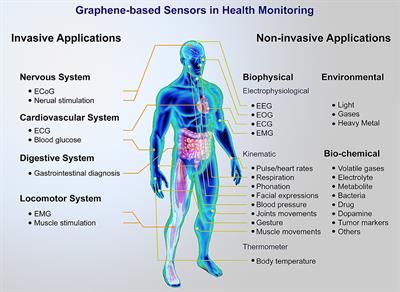- 1SEU-FEI Nano-Pico Center, Key Lab of MEMS of Ministry of Education, Collaborative Innovation Center for Micro/Nano Fabrication, Device and System, Southeast University, Nanjing, China
- 2Center for Advanced Materials and Manufacture, Southeast University-Monash University Joint Research Institute, Suzhou, China
- 3Center for Advanced Carbon Materials, Jiangnan Graphene Research Institute, Southeast University, Changzhou, China
Since the desire for real-time human health monitoring as well as seamless human-machine interaction is increasing rapidly, plenty of research efforts have been made to investigate wearable sensors and implantable devices in recent years. As a novel 2D material, graphene has aroused a boom in the field of sensor research around the world due to its advantages in mechanical, thermal, and electrical properties. Numerous graphene-based sensors used for human health monitoring have been reported, including wearable sensors, as well as implantable devices, which can realize the real-time measurement of body temperature, heart rate, pulse oxygenation, respiration rate, blood pressure, blood glucose, electrocardiogram signal, electromyogram signal, and electroencephalograph signal, etc. Herein, as a review of the latest graphene-based sensors for health monitoring, their novel structures, sensing mechanisms, technological innovations, components for sensor systems and potential challenges will be discussed and outlined.
Introduction
As the global population is growing rapidly and the life expectancy of humans is increasing drastically (Vaupel, 2010; Takei et al., 2015), the healthcare system is facing increasing expenses and burdens, requiring governments to find feasible solutions to render adequate medical care without increasing healthcare costs (Pantelopoulos and Bourbakis, 2010). Preventive and personalized medicine approaches (Ng et al., 2009), which change with health status, can be detected and diagnosed early. Disease-risk can also be predicted, and utilized to overcome challenges by increasing the cure rate and survivability of an at-risk population, while minimizing the overall treatment costs (Narayan and Verma, 2016; Tricoli et al., 2017). By periodically or continuously tracking critical signs and biomarkers, health monitoring systems are capable of comprehensively assessing health conditions which can remarkably benefit the diagnosis and diseases treatment along with postoperative rehabilitation, which can significantly reduce the burden of medical systems and improve quality of life (Yao et al., 2017).
As a critical component of health monitoring systems and the interface to the human body, sensors, including wearable and implantable sensors, are able to detect and measure various signals or analytes with high specificity and sensitivity (Narayan and Verma, 2016). Indeed, due to the mechanical mismatch between the human skin (or soft biological tissues) and conventional rigid silicon-based sensors, mechanical flexibility is notably essential for these invasive or non-invasive sensors (Wang et al., 2017). Moreover, several constraints including biocompatibility, reliability, stability, comfort, convenience, miniaturization, costs, and biofouling should also be considered or even traded for location-unlimited, long-term, multifunctional, real-time, unobtrusive, pervasive, affordable health monitoring (Pantelopoulos and Bourbakis, 2010). Furthermore, recent impressive data management and analysis methods, such as Big Data (Murdoch and Detsky, 2013; Bates et al., 2014; Raghupathi and Raghupathi, 2014), and machine learning (Ravi et al., 2017) technology are applied in data handling and effective information mining (Banaee et al., 2013), since a large amount of data can be collected by these sensors (Someya et al., 2016). Consequently, personal data security and privacy should be effectively guaranteed.
Graphene, owing to its extraordinary multiple properties, such as ultrahigh carrier mobility (Novoselov et al., 2004; Weiss et al., 2012), excellent electrical conductivity, superior thermal conductivity (Balandin et al., 2008; Balandin, 2011), large theoretical specific surface area (Zhu et al., 2010), high optical transmittance (Nair et al., 2008), high Young’s modulus (Lee et al., 2008a) and outstanding mechanical flexibility (Yang H. et al., 2018), is a promising 2D material in many applications, especially for the development of wearable sensors and implantable devices in health monitoring. Various and multifunctional sensors can be realized, which benefits from the performance diversities of graphene. The advantages of graphene for sensors are summarized as follows: the first point is that the high specific surface area and the atomic thickness of graphene layers render entire carbon atoms directly in contact with analytes, as a result, graphene-based sensors have superior sensitivity compared to silicon (Justino et al., 2017). In addition, conformal, intimate contact with organs of interest such as the skin (Ameri et al., 2016), brain (Park et al., 2017) and eyes (Kim et al., 2017) can be achieved by graphene-based sensors, because of the mechanical flexibility and ultrathin thickness of graphene, which is essential in acquiring high-quality signals without irritation, motion artifacts, or contamination (Ray et al., 2018). Moreover, high optical transparency and electrical conductivity renders graphene an ideal material for bio-tissue observation with clear images and without visual disturbances (Lee et al., 2015). Furthermore, a high signal-to-noise ratio (SNR) can be achieved in electrophysiological signals recording by the conformal integration and the efficient signal transmission depending on the high electrical conductivity (Ameri et al., 2016). Additionally, the superior performance of graphene in biosensors, such as large specific surface area, convenient functionalization, wide potential window as well as high electron transfer rate, allows receptors such as enzymes, antibodies and deoxyribonucleic acid (DNA) to be efficiently immobilized on the surface of graphene (Szunerits and Boukherroub, 2018). More discussions on the properties, synthesis, characterization, and other applications of graphene and its derivatives have been reported in previous review papers and are not included in this review due to limitations in space (Soldano et al., 2010; Huang M. et al., 2011; Huang X. et al., 2011)…READ FULL ARTICLE HERE… | Chemistry (frontiersin.org)


 Haizhou Huang1†,
Haizhou Huang1†,  Shi Su
Shi Su Shu Wan
Shu Wan


